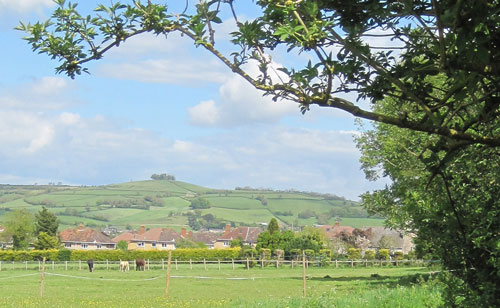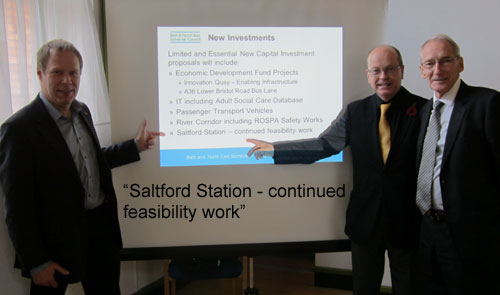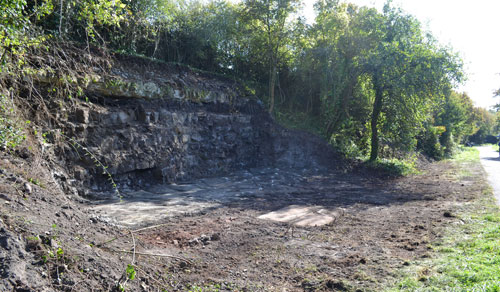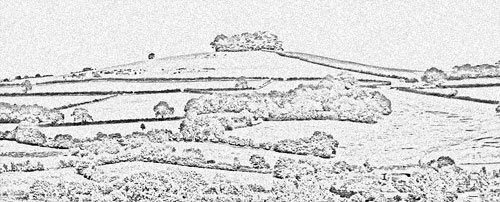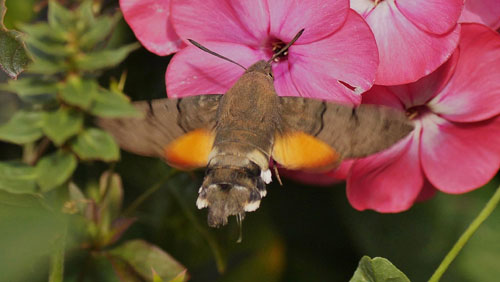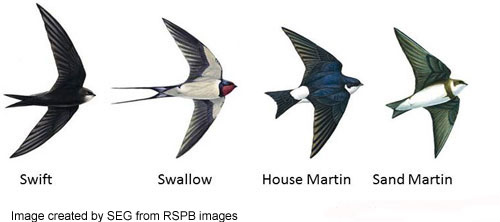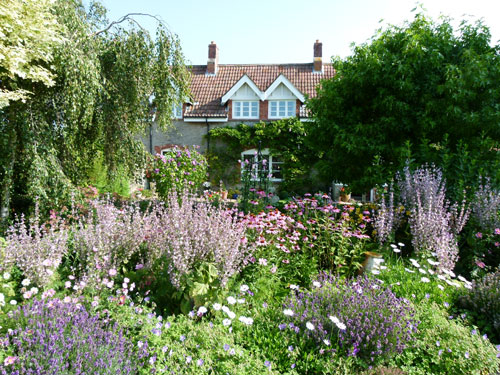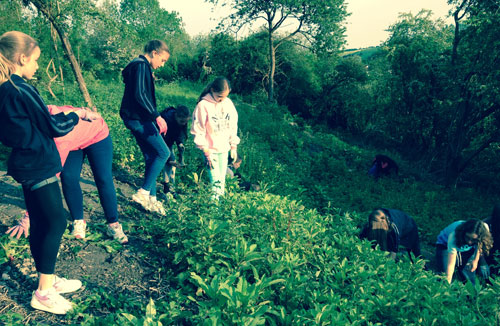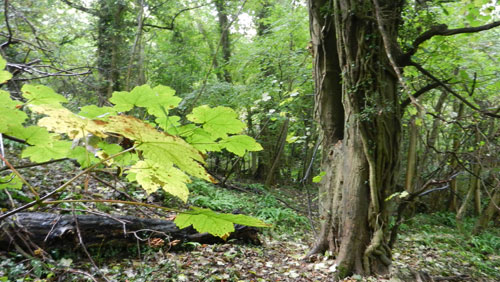|
Saltford Environment Group
|
| Home | About Us | News | Website Contents & Links | Contact |

|
SEG Home > News List > 2014 Archive 2014 (archive)NOTE: Our newsletters for 2014 were sent by email and not posted on our website. For our archive records we have published just a few key newsletter stories from 2014 here. Some links to external websites may have ceased to function if those websites have moved or deleted content.
These fields in Saltford's Green Belt, south of Manor Road, were the subject of the Planning Inquiry. Photograph © Phil Harding 2013 Click on each story headline link or scroll down the page:-Saltford station - bringing it back New rock exposure on the railway path Do the young birds raised in our gardens return? New 'Saltford Wombles' group to target litter "What if?" questions about reopening our station From Saltford to Bristol to New York Hummingbird Hawk-Moths in Saltford Saltford's Green Belt safe for now Remaining vigilant for ash dieback Giant Hogweed: Second Occurrence Core Strategy: NO development recommended on Saltford's Green Belt Can you identify the Swifts and Swallows over Saltford? Open garden at Eastover Farm proved popular Railway Path Habitat Restoration Project update Saltford station: Consultation shows strong support The value of deadwood to our local ecosystems Railway Path Habitat Restoration Project - An opportunity to get involved Saltford Green Belt Inquiry: Secretary of State determines against the development! Station consultation drop-in event Tuesday 25th February - be there if you can! Government incentives for fracking New threat to Saltford's Green Belt - merge Keynsham and Saltford?! Saltford's Placemaking Plan Published More White Christmases?Recent tentative research from the University of Tokyo suggests that the impacts of warming in the Arctic due to climate change may increase the risk of colder winters for Europe. A decline in sea ice is thought to contribute to the development of weather systems that can bring cold Arctic air further south during the winter months. But the research also proposes that in the longer term, these cold winters won't dent the overall warming trend. In the meantime, England's Cold Weather Plan 2014 from Public Health England includes a review on the requirements for minimum indoor temperatures for homes. The review includes the finding that the 18degC threshold is particularly important for vulnerable groups (pre-existing medical conditions, over-65s) to maintain good health. Sources of advice and grants for making your home more energy efficient and thus warmer in winter can be found on our Energy page. Members with a professional interest (e.g. working in healthcare) in the Cold Weather Plan can find it at https://www.gov.uk/government/collections/cold-weather-plan-for-england. December 2014Saltford station - bringing it back
Important progress was made for our station campaign during November. On 4th November Cllr David Bellotti, B&NES Lib Dem Cabinet Member for Community Resources, at the B&NES Budget Fair meeting in Bath said that the Council was "very committed to Saltford station" and announced £250,000 in the proposed Lib Dem budget for 2015/16 to take the re-opening of Saltford station forward to Network Rail's GRIP (Guide to Railway Investment Projects) stages 3 and 4. These stages involve much more detailed work on costs, design and finance. The first 4 GRIP stages are about planning and the final 4 are concerned with implementation. This strong backing from the B&NES Cabinet is an important milestone in our long and popular campaign to reopen the station. The 2015/16 Budget will be voted upon by the full Council on 17th February 2015 and once approved work on GRIP stages 3 and 4 can proceed in the new financial year. We anticipate cross-party support for this aspect of the 2015/16 Budget. At national party level, in addition to the long-standing support from our Conservative MP, Jacob Rees-Mogg, we have received statements of support from the Lib Dem and Labour Parliamentary candidates Wera Hobhouse and Todd Foreman. Furthermore in addition to support from the Lib Dems on B&NES Council, the leader of the Conservative Group of B&NES Councillors, Cllr Tim Warren, has also expressed his group's full support for opening Saltford station. The statements of support from our political representatives can be found on our website's station page. On 12th November Duncan Hounsell, representing the station campaign, addressed the B&NES Cabinet at their monthly meeting. He acknowledged the support for our station from the Council and that several surveys had shown that a large majority of people in Saltford want the station re-opened. He also said that the re-opening of Saltford station would not just be good for Saltford's hard-pressed commuters but would play a part in reducing congestion along the A4 Corridor and make a contribution to the emerging Transport Strategies for Bath and for Keynsham. B&NES Council Cabinet will be discussing the latest report from the consultants CM2Hill exploring the feasibility of the station at their Wednesday 3rd December meeting in the new offices in Keynsham ('Keynsham Community Space') at 6.30pm. The station campaign has received permission from B&NES to address the Cabinet at that meeting. December 2014New rock exposure on the railway path
Phase 1 of the Saltford Railway Path Geology Project led by field naturalist and geologist Simon Carpenter to create a permanent rock exposure on the former railway line was successfully completed on 3rd October. This initial clearance with a mechanical excavator involved the removal of loose rock fragments and vegetation covering a section of the rocks in the cutting. Phase 2, the final clearance, will be completed by hand using community volunteers (Trust for Community Volunteers) using hand tools and brushes. This work is likely to take two days during November. The site is located between the Avon Lane gated access and the Avon Lane footbridge (if joining the railway path at the 'Bird in Hand', turn left towards Bitton and the exposure can be seen after a short distance on the right hand side). The rocks here are approximately 190 to 200 million years old and were formed during the Lower Jurassic period. We have posted a photograph of the rock exposure on the new web page about Saltford's Geology. November 2014Jurassic Saltford now online!
With support from SEG members and local geologists Simon Carpenter and Dick Stabbins, SEG has published an illustrated and fascinating new feature page about Saltford's Geology on our website. As well as being an educational resource, this highlights and provides a showcase for Saltford's outstanding geological features including information (with images) on its Lower Jurassic rock formations, fossils, ancient reptiles and the geology of the surrounding area including the popular landmark Kelston Round Hill. At 165-170 million years old Kelston Round Hill is about 30 million years younger than Saltford's Blue Lias limestone. If you haven't seen this new feature page yet, check it out from this link: Saltford's Geology. More developments are planned for this page so watch this space! November 2014Do the young birds raised in our gardens return?You may wonder whether the young birds hatched from nests and bird boxes in your garden come back in subsequent years to raise their young in your garden too. Greater knowledge about the behaviour of birds is growing rapidly now that bird trackers used by ornithologists are tiny and can be used on smaller birds. The current thinking in the ornithological world is that once young birds leave the nest from where they hatched, it is unlikely that they will return to it or to the same area. This is because it is thought birds have an in-built mechanism to reduce the chance that they would mate with their own parents or siblings. This instinct tells the females and males to travel, on average, different distances to find a mate and raise their own young. Migratory birds like Swifts and Swallows return to the same nest-site each year but the young of these species seldom return to their birthplace. It has been observed that a significant number of different Blackbirds visit the same garden in a day so we cannot assume the birds we frequently see are necessarily the same individuals. In summary, whilst the adult birds that raise young in your garden may return and raise new broods current evidence suggests that young birds will almost certainly re-locate to start their own families elsewhere. It will be interesting to see if further ornithological studies using the latest tracking technology continue to bear this out. November 2014New 'Saltford Wombles' group to target litterSEG is pleased to announce that we are setting up a Saltford Wombles group. So, if you hate litter and waste and want to get involved in helping make Saltford a cleaner, litter-free village, do get in touch with Julie Sampson so that Julie can advise you of the emerging plans for this new group. Encouraging residents to be more proactive on picking up litter and targeted litter picks for problem areas are just some of the things Saltford Wombles will be doing. All ages welcome. Other towns and villages have their own Wombles (e.g. Keynsham Wombles) that have proved to be fun ways of helping the community look after its own environment effectively and keep litter down to a minimum. Interested in getting involved? Please contact Julie - more information about Saltford Wombles appears on our website's "Less Waste" page. October 2014"What if?" questions about reopening our station
Asking the right question can help people focus their minds on important issues. Below are some "What if?" questions concerning our station that we have added to our station page. If members have any additional suggestions for short pithy "What if?" questions about getting our station back send them to our website editor and we may feature them (anonymously) on our website. What if motoring and bus travel becomes much more expensive and we haven't got a local option to travel by train? What if free bus passes are withdrawn and we've missed the chance to get our station back? What if congestion on the A4 increases but we had missed this opportunity to get our station back for local commuters? What if you could leave the car at home and travel to your destination from Saltford by train? What if visitors had the option to arrive in Saltford by train? October 2014From Saltford to Bristol to New York
Members from SEG attended the People's Climate March in Bristol on the afternoon of 21st September and posed the question for climate sceptics watching the march "What if we are wrong about climate change and we create a better world for nothing..?"
2,808 solidarity events in 166 countries made the weekend of 20/21 September the largest non-party political climate march in history to tell world leaders meeting at the UN summit on climate change in New York on 23rd September that "There is no planet B" and that there is strong public support for real and immediate action to address the climate crisis. Many different organisations were involved including Avaaz, 38 degrees, 350.org, WWF, Christian Aid, and Oxfam. Over 2,000 people participated in the Bristol march that started in Castle Park, passed through the Broadmead shopping centre and ended at College Green where a petition was presented to Molly Scott Cato, the Green Party MEP for the South West. The assembled gathering was also addressed via live telephone link by Bristol's Mayor George Ferguson from New York where he was attending the UN summit. October 2014Hummingbird Hawk-Moths in Saltford
One insect well worth looking out for in Saltford on the last remaining sunny days of our summer and early autumn is the fascinating Hummingbird Hawk-Moth. Native to North Africa and southern Europe, the Hummingbird Hawk-Moth has been observed in Saltford during this summer (as recently as the second half of August) and it is now increasingly common in southern England. This remarkable day-flying moth is named from its appearance that is very similar to a hummingbird as it hovers, probing flowers for nectar with its long proboscis. It is smaller than any hummingbird but if you are close enough you can hear a hum from its fast beating wings. The Hummingbird Hawk-Moth drinks the nectar from flowers, such as Red Valerian, Honeysuckle, and Buddleia, and can be seen hovering and probing nectar-rich flowers in sunny locations. More information and photographs to help you identify this moth can be found on our wildlife web page under "Butterflies and day-flying moths". Once you've seen one at close range you'll never forget its appearance. September 2014Saltford's Green Belt safe for nowOn 10th July B&NES Council adopted its Core Strategy (for planning and economic development until 2029). The good news for Saltford is that our Green Belt land is NOT identified for development despite lobbying from developers to the contrary. SEG, our Parish Councillors, and our B&NES Councillors have strongly resisted inclusion of our Green Belt for development during the discussions, lobbying and consultations with B&NES Council. Whilst we welcome this news, SEG naturally has concerns that other parcels of Green Belt land in the B&NES area will be developed including land East of Keynsham which will have a negative effect on the existing traffic congestion on the A4 and surrounding roads, quite apart from the unsustainability of developing such land. The adopted Core Strategy taken together with the outcome in our favour of the Saltford Green Belt Inquiry will make it significantly harder for developers to win planning permission on appeal to build on Saltford's Green Belt. This protection should last at least until the Core Strategy is amended following, for example, a 5-yearly review or a major change in Green Belt policy at national level. The first Core Strategy review may be as early as 2016 to coincide with a review of West of England Core Strategies although that review will not necessarily affect our Green Belt. Nevertheless we shall need to remain vigilant for future threats to our Green Belt from developers or changes to planning policies. More information can be found on our Green Belt page. August 2014Remaining vigilant for ash dieback[This article appears in a new section about "Trees" on our wildlife page.] Found widely across Europe, ash dieback disease is spread by the Chalara fraxinea fungus, a fungus that was found in England in 2012 after being imported in infected trees from Holland. It causes the crown of ash trees to blacken and wither, and eventually kill the tree, killing younger trees more quickly. Experts advise that the spread of the disease cannot be stopped, and are resigned to mitigating the worst distribution and impact of the organism on the UK's estimated 80 million ash trees. Local spread of spores, up to some tens of miles, may be by wind (including possibly from mainland Europe) whereas over longer distances the risk of disease spread is most likely to be through the movement of diseased ash plants. Movement of logs or un-sawn wood from infected trees might also be a means of transmission but that is considered to be low risk. Chalara fraxinea is treated as a quarantine pest under national emergency measures and any suspected sighting must be reported. So far, no trees have been identified within B&NES but the Council is reliant on residents remaining vigilant. If you find a tree which you think is infected please report it; the B&NES web page with contacts for reporting ash dieback is at www.bathnes.gov.uk/services/environment/trees-and-woodlands/ash-dieback-disease. If you're not sure that you've identified ash dieback the Forest Research Disease Diagnostic Advisory Service can be contacted on tel: 01420 23000, email ddas.ah@forestry.gsi.gov.uk or the Forestry Commission's Chalara helpline is: 08459 33 55 77, email plant.health@forestry.gsi.gov.uk. The Forestry Commission has the latest scientific research and other information on ash dieback at www.forestry.gov.uk/chalara. In and around Saltford, the landscape changed enormously with the loss of mature elms in the 1970s. As a result, ash became an even more important tree for wildlife away from woods and river-banks, and is a major constituent of native woods. Losing such an important tree to our landscapes and wildlife is obviously a major concern. Some ash trees may have a genetic resistance to this disease so it makes sense not to cut down healthy ash trees unless absolutely necessary. August 2014Saltford on the webRowing, cycling, sailing, tennis, golf, U18 football, wildlife, local history, amateur dramatics, Saltford Brassmill, Saltford Community Association, Saltford Parish Council, St Mary's Church, Saltford School, Saltford Business Network - you name it, a lot happens in our village! SEG's links page on our website is like a local hub with some 50 links to websites of interest or relevance to your community. August 2014Giant Hogweed: Second OccurrenceA second sighting in 2014 of the highly toxic Giant Hogweed plant in a public area of Saltford has been made by SEG in July and reported to B&NES for prompt attention. We are not sure why this plant has occurred twice this year in two different parts of the village but as it is such a toxic plant it is important for the safety of each of us and our families that members are alert to it when out and about in Saltford. Our wildlife web page has information about the health hazards associated with the plant and images to help you identify it (link). If you find Giant Hogweed in Saltford DON'T TOUCH IT but report it to B&NES and let SEG know too as we are currently monitoring the situation. August 2014Core Strategy: NO development recommended on Saltford's Green BeltWe are delighted to inform you that Simon Emerson, the Core Strategy Inspector, has issued his final report arising from the Core Strategy Examination Hearings held during March/April and that he does NOT recommend inclusion of Saltford's Green Belt in the Core Strategy. Developers had sought inclusion of our Green Belt for housing development, something SEG and others had lobbied strongly against over a lengthy period (both behind the scenes and publicly). This outcome is excellent news for the village and its protection from widespread unsuitable development and the resulting loss of its rural character and natural environment. The Core Strategy is the economic and planning strategy for this area's development over a 15 year period (to 2029) and determines where new housing will be located. Once agreed (hopefully by the end of this year) the Core Strategy is normally subject to review every 5 years. The report was issued in readiness for discussion by the Full B&NES Council on 10th July. Proposals to develop four strategic Green Belt sites (South West Keynsham, East Keynsham, Odd Down, and Whitchurch) were recommended but the proposed site at Weston, Bath, an Area of Outstanding Natural Beauty, was not. Further information about the Inspector's report can be found on our Green Belt web page. July 2014Can you identify the Swifts and Swallows over Saltford?Even when our skies are grey, a sign of summer is when the Swallows, Swifts and House Martins can be seen flying their acrobatic displays overhead as they pluck flying insects and airborne spiders from the air. They are welcome summer visitors to Britain, but can you readily identify the different species just from their shape when they are in flight? The larger Swifts have longer scythe-shaped wings and short tails, Swallows have long tail streamers, and House Martins have a more dumpy appearance and much shorter tails. It is Swifts you can hear screaming overhead. Swifts appear to be all black, although close up they are dark brown. House Martins and Swallows both have white undersides with a glossy blue-black back but the Swallow has a distinctive red chin and throat. The Sand Martin, also observed in Saltford, is similar in shape and can be confused with the House Martin but its white underside is divided by a dark breast band just below its head and it has a brown back.
The above illustration that we created from RSPB images can help you identify and distinguish these amazing birds. July 2014Open garden at Eastover Farm proved popular
A huge thank you to the hosts, Ray and Penny Buchanan, everyone who baked a cake, our Fairtrade Group, Signs of Saltford, Saltford Community Association, Saltford Girl Guides for helping with the catering arrangements, the local Tesco, Waitrose and Co-Op stores for donating Fairtrade cake ingredients and all those working behind the scenes to make the open garden and wildflower-meadow event at Eastover Farm so enjoyable on Sunday 29th June. It was clear from the comments received from several of the 170+ who attended that this was an inspiring way to spend a summer's Sunday afternoon. We hope many found the gardens showed how attractive and inspiring wildlife-friendly gardens can be. July 2014Did you know this about bugs?One in 3 mouthfuls of our food depends on insect pollination. Honey, chocolate, and coffee wouldn't exist without invertebrates. 90% of wildflowers would become extinct if there were no bugs pollinating them. Bugs break down and recycle waste, help to clean our fresh water and eat rotting fruit. No bugs means no songbirds, otters, fish or frogs - our countryside would be empty and silent. (Source: Buglife). Interested in bugs? Our wildlife web page has a link to the Buglife website. The garden and wildflower meadow at Eastover Farm in Manor Road has an open day on 29th June and provides a classic example of how our gardens can be both beautiful and bug-friendly. June 2014Railway Path Habitat Restoration Project update
Many thanks to Saltford Girl Guides who spent the evening of 21 May pulling weeds and in particular Himalayan Balsam at the project's cleared area. Their enthusiasm and effort in clearing so much of the re-growth in one session is much appreciated. The project continues to receive positive comments from members and railway path users on the enhanced look of this stretch of the path. The project now has its own web page on our website and can be found from the link on our wildlife page. The cleared area is on the west facing embankment of the Bristol to Bath railway path (a short way towards Bath from the Bird in Hand). We have sent our project progress report to the Avon Frome Partnership who co-ordinate the maintenance and development of the railway path. We have agreed with them that we shall organise occasional vegetation regrowth clearing sessions on the pilot area during the summer rather than encouraging members to turn up at unsupervised times. Our objective is to keep the re-emerging tall coarse plants, brambles and saplings down. This will allow the former wildflower-rich rough grassland habitat to begin to re-establish itself. If you would like to help with the occasional organised clearance sessions in the summer months, please contact our vice-Chairman, Chris Warren, by email to cherokee1883@live.com. Chris will add you to the list of volunteers so that you can be alerted to forthcoming organised sessions. Full instructions and advice for volunteers can be found on the project's web page. June 2014Ticks and Giant HogweedAfter the mild winter health experts have warned that ticks appear to be on the increase across the UK. We have provided NHS advice on how to safely remove ticks from your or your child's skin on our wildlife web page. Our wildlife adviser Will Duckworth spotted a clump of the toxic plant Giant Hogweed by the side of the railway path in May; this is thankfully a rare occurrence in Saltford and is well away from our habitat restoration project. If touched, this plant can cause severe and long lasting skin reactions. It was promptly reported to B&NES who have taken action to destroy it. For more information about Giant Hogweed see the illustrated article on our wildlife web page. June 2014Saltford station: Consultation shows strong supportThe results of the Saltford residents' consultation survey carried out by B&NES Council at SEG's request on the possible re-opening of Saltford Railway Station have been released by B&NES Council. 370 questionnaires were returned. 68.9% (255) wanted a station at Saltford and 20.5% (76) did not, with 10.6% (39) not having a view. If a station was to be provided, 62.7% (232) said that they would walk to it and 10.8% (40) said they would cycle whilst 11.7% (43) said they would drive. The result is good news for our station campaign. B&NES expects to receive the consultant's report in early summer and will then make a decision on funding the project to the next stage. May 2014The value of deadwood to our local ecosystems
We are often tempted to clear away dead or decaying trees, logs, twigs etc. from our gardens but did you know that over a third of woodland wildlife is dependent on deadwood? There is an extensive range of deadwood-dependent organisms including fungi, lichens, invertebrates, mosses and birds, many of them having very specific requirements, and some specialising exclusively on one particular microhabitat. For all species to persist, deadwood of all sizes from massive trunks to twigs, both standing and fallen, and at all stages of decay from freshly dead until rotten away, are important. During April we posted a short article on our website highlighting the value of deadwood to our local ecosystems. The article can be found on our wildlife page. May 2014Green Belt Inquiry outcomeWe were delighted to inform you by email on 5th March that the Secretary of State Eric Pickles had dismissed the appeal and refused planning permission for Crest Nicholson to build a housing estate of up to 99 dwellings on the fields south of Manor Road in the Green Belt. Our website carries further information about this important decision in Saltford's favour. SEG would like to thank everybody in the village that supported the campaign to protect our Green Belt before, during and after the Inquiry. This includes all of you who submitted a planning objection, gave messages of encouragement to the team working on your behalf, displayed a poster, signed the Saltford Green Belt Campaign petition, or demonstrated at and/or attended the Appeal Inquiry last August. Do use this excellent news to encourage others in the village to join SEG so that we can carry even more influence when taking on future similar challenges. We know that other attempts are being made by developers to include our Green Belt for housing development in the B&NES Core Strategy; SEG is monitoring the situation and has been lobbying B&NES. April 2014Railway Path Habitat Restoration Project - An opportunity to get involvedThe clearance of an initial stretch of woody regrowth (young trees) and other coarse tall vegetation on the west facing embankment of the Bristol to Bath railway path (a short way towards Bath from the Bird in Hand) was completed during autumn - winter 2013/14. Already numerous insects have been observed in the cleared area during sunny spells and a long lost view across fields to the river has re-emerged. From April to August (inclusive) you have the opportunity to turn up at a time and on any day(s) convenient to you to help do some vegetation clearing so that between us we can keep the re-emerging tall coarse plants, brambles and saplings down - and remove any non-degrading litter that also appears. This will allow the former wildflower-rich rough grassland habitat to begin to re-establish itself. We hope several of you, perhaps as a family, small group of friends or as individuals, will enjoy doing just a few short stints on this habitat restoration project over the spring and summer. Full details can be found on our website's special page about this project where we also have specific instructions and advice for volunteers - you are requested to read these before taking part. April 2014Saltford Green Belt Inquiry: Secretary of State determines against the development!
The following is an extract from a press release issued by your Chairman Phil Harding on behalf of Saltford Environment Group this afternoon (Wednesday 5th March 2014):- Saltford Green Belt Inquiry: Secretary of State determines against the development!Following his decision, announced on 18th September, that as "the appeal involves proposals for significant development in the Green Belt" he would determine the appeal himself for the Crest Nicholson planning application to build up to 99 dwellings on Saltford's Green Belt south of the Manor Road fields, the Secretary of State for Local Government and Communities, Eric Pickles, has ruled in favour of not allowing the proposed development on Saltford's Green Belt to proceed. The following is a statement by Saltford Environment Group in response to that news:- SEG welcomes this decision. The Secretary of State, on examining the evidence given at the Inquiry and the Inspector's report, has overruled the Inspector's recommendation to allow the development. The Secretary of State's overall conclusions were: - that the appeal proposals are inappropriate development in the Green Belt. Additionally he has identified harm to the Green Belt's openness and harm to the Green Belt's purpose of preventing encroachment into the countryside. However he disagrees with the Inspector about the extent of that encroachment and attaches considerable weight to this issue. Overall, he considers that, together, this represents considerable harm, to which he attributes substantial weight. - that there are factors in favour of the appeal including the substantial shortage of deliverable housing land in B&NES and that, setting aside Green Belt, development of the appeal site would not cause demonstrable harm. However, having weighed up all material considerations, he is satisfied that the factors which weigh in favour of the proposal do not clearly outweigh the harm to the Green Belt that would arise from the proposal. The Secretary of State therefore concludes that the appeal should be dismissed. We wish to thank everyone who joined the campaign to oppose the proposed housing development on Saltford's Green Belt. We especially wish to recognise and thank the Saltford Green Belt Campaign for helping to demonstrate the residents' opposition to building on Saltford's Green Belt. We would also like to thank local councillors from all political parties who opposed this planning application, our MP Jacob Rees-Mogg for his advice and support, B&NES Council Planning Department for its work relating to this Inquiry, and also our Parish Council for its support. As we have reported on our website in recent weeks, we are conscious that there may be further attempts by developers to build on our Green Belt. This important decision by the Secretary of State does show that the community was right to defend Saltford's Green Belt. We hope progress on the Core Strategy can be made rapidly so that we do not face a similar situation again. March 2014SPECIAL STATION NEWS LETTER 20TH FEB Station consultation drop-in event Tuesday 25th February - be there if you can!Dear SEG members Providing a high turnout and positive response to B&NES at Saltford Hall on 25th February (drop-in between 4pm and 8pm) is crucial if all the work and effort since 2011 to get our station onto the local and regional transport agenda is not to have been in vain. If we miss this once in a lifetime opportunity to get our station back, present and future generations of all age groups living in Saltford who need or want a low carbon transport alternative to road travel will wonder how we lost out. We cannot predict the future of road transport in the area, but increased congestion seems inevitable, wasting more time and fuel for commuters and visitors. Future-proofing our village with a rail option makes economic, social and environmental sense. To see the forthcoming half hourly Metro West rail service between Bristol and Bath pass through Saltford without stopping would be plain crazy. Council transport officers will be at the event to answer questions from residents about the proposals, whilst station campaign members will also be there to provide information on why we are so certain that the station would strongly benefit Saltford and that solutions to expressed concerns over parking and access do exist. It is vital that members and their family and friends in the village who are in favour of the station attend the drop-in event in large numbers and give a positive response. With electrification of the main line, new signalling and the arrival of the Metro West service, we really cannot afford to watch new railway investment pass us by. We look forward to seeing as many of you, your family and friends there as possible. Let's show B&NES Saltford thinks ahead! More information about the station campaign including frequently asked questions can be found on our station page. March 2014Government incentives for frackingMembers may be wondering what the implications might be for our area following Prime Minister David Cameron's announcement in January that local authorities will be able to keep 100% (double the usual 50%) of the business rates they collect from shale gas sites. In July 2013 BaNES Councillors from all political parties supported a motion from Cllr Tim Warren on behalf of the Conservative Group, about the Council's "serious concerns about the potential impact of unconventional gas exploration and extraction, as well as geothermal exploitation, within Bath and North East Somerset", and that the Council "should seek to adopt whatever measures available to control, and if appropriate prevent, the use of unconventional gas exploration and extraction, as well as geothermal exploitation, within Bath and North East Somerset". The Council has continued to hold this line in response to the Government's announcement. SEG understands from a local geologist that Saltford itself is unlikely to be a target for fracking companies as the geological formations do not provide the shale rock or coal beds necessary for the production of shale gas or coal bed methane. However some of the surrounding area could provide potential sources of shale gas or coal bed methane. If you want to know more about fracking, see the fracking page on our website (via our energy page). Also "Frack Free February" is a 'Month of Action' in Somerset with public meetings, film showings (including Frack Free Somerset's new film 'The Truth Behind the Dash for Gas'), talks, stalls, workshops, actions and more all raising awareness about the potential impacts and threats to our communities and the bigger picture of fracking and onshore gas. It provides an opportunity for you to learn more about this controversial subject. February 2014New threat to Saltford's Green Belt - merge Keynsham and Saltford?!SEG became aware on 5th December that the developers for the east of Keynsham Green Belt development, Mactaggart & Mickel Ltd, also wish to build on the Green Belt between Saltford and Keynsham, on land directly adjacent to Grange Road and surrounding Copse Road. The proposed development was not in the public consultation documentation launched on 23rd November 2013 for the east of Keynsham Green Belt development but an outline plan appears on the B&NES Core Strategy website with other core documents. It is part of Mactaggart & Mickel Ltd's master plan for development in this area. At the time of writing this article, no planning application for such a development has been submitted. SEG is naturally strongly opposed to this proposal. The Green Belt land at this location serves several purposes described in the National Planning Policy Framework (NPPF) as reasons for protecting the Green Belt from development, namely: to check the unrestricted sprawl of large built-up areas, to prevent neighbouring towns merging into one another, to assist in safeguarding the countryside from encroachment, and to encourage the recycling of derelict and other urban land. SEG has been in contact with our Parish Council's Planning Committee about this development. We also made direct contact with the Planning Department at B&NES. As this is not in the Core Strategy proposals from B&NES, B&NES is not supportive of this development and is NOT currently proposing to release any land from the Green Belt on the Saltford side of the gap between Saltford and Keynsham. There is the remote risk that the Inspector examining the Core Strategy, Simon Emerson, might ask B&NES to look again at proposals like this despite it being on the Green Belt and a development that would be contrary to Saltford's Placemaking Plan (completed in December 2013 - see story further down in this newsletter). However, as this would represent a change to the Core Strategy B&NES would need to consult on such a modification before it could be adopted in the Core Strategy. We have posted further information including a link to the outline plan on our website. We shall update our website as the situation develops. January 2014Saltford's Placemaking Plan PublishedSaltford's Placemaking Plan was produced by a Working Group appointed by the Parish Council and published on the Parish Council website just before Christmas. The community was consulted on its contents between 23 November and 6 December 2013. The purpose of this plan is to complement the strategic planning framework provided in Bath & North East Somerset Council's Core Strategy. It provides an updated and refreshed planning policy framework for managing development in the Parish of Saltford. The plan breaks Saltford down into 7 distinct character zones: Green Belt, Conservation Area, housing settlements (north and south of the A4), river Avon frontage, A4 corridor and the two large satellite sites within the Green Belt. No land has been identified for new housing developments and this plan will be used by the Parish Council and SEG to help defend against further attempts by developers to build on our Green Belt. Our website has a link to the plan (on the Parish Council's website). January 2014© Saltford Environment Group |
Editorial policySEG as an independent, non-profit making body takes a politically neutral stance. We are committed to the highest editorial and ethical standards in the provision of all the content and related services for our news items and website. Editor Deputy Editor The Editorial team can be contacted via our home page. |

